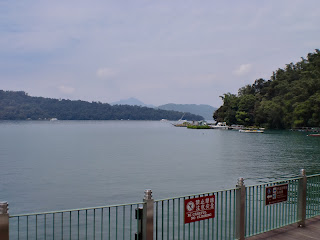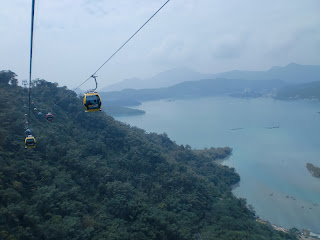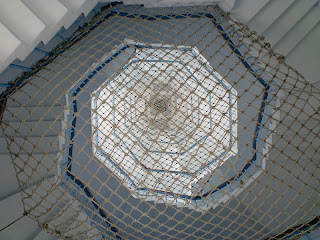昨日の続きで、日月潭で撮った動画も載せる。お楽しみに。
Sunday, September 30, 2012
日月潭の動画も
Saturday, September 29, 2012
日月潭/Sun Moon Lake
日月潭について書くと約束したから、行くぞ!
先週、授業が始まる前に他の留学生二人と一緒に行って来た。日月潭は台湾のかなり有名な観光地だ。トップファイブに絶対入る。中国人にとっては凄く人気が有るから、週末に行ったら中国人が沢山入っている観光バスでいっぱいに成っているらしい。
俺達は水曜日に行って、木曜日に帰って来たので、そこまで込んでいたんじゃない。又、場所によって人が全く居ないところも有った。
I told you I'd write about Sun Moon Lake, so here it is.
Sun Moon Lake is one of the most popular tourist destinations in Taiwan. In particular it is supposed to be really popular with Chinese tourists, so I've heard that if you go on the weekend it's totally overrun with tour busses filled with Mainlanders.
I went with two other foreign students. We left on Wednesday and returned on Thursday, so we didn't hit as many crowds as we might have otherwise.
先ずは電車で台中まで行って、そこからバスに乗った。日月潭は山に有る。750メートル弱の高さで、日本時代にダムされて、拡大してから台湾の最大の湖に成った。半分は太陽の形に成っている、半分は月の形に成っていると言われている。(俺には見えないけど、、、)We took the train up to Taichung, and then a bus from there. Sun Moon Lake is about 750 meters above sea level and surrounded by mountains. It's the biggest lake in Taiwan, though it's current size is greatly increased by a damming project done under the Japanese government. Supposedly half of the lake is shaped like the sun, and half like the moon, but I personally don't really see it.
This is Suishe, one of the two main towns around the lake. This area is the traditional home area of the Thao tribe, one of Taiwan's indigenous, Austronesian tribes. They're the smallest officially recognized tribe in Taiwan with only about 500 members.
The two towns are pretty built up as a result of the tourist industry. Most of these buildings are hotels or restaurants.
「水社」と言う町だ。湖の周りにこれともう一つの「伊達邵」(イダサウ)が主な町だ。日月潭の周りに邵族が昔から住んでいる。彼等は台湾のもっとも人数の少ない正式的に政府に認められている部族だ。約500人しか居ない。
この水社は日本に有る山の温泉町みたいな感じがする。周りには綺麗な自然しか無いけど、やはり観光業が発展しているから、町自体はホテルとレストランばかりに占められている。
The first thing we did upon arriving was walk a little way around the lake on this nice wooden path they've installed right above the water line.
リンボースポット
水の色は本当に凄い。何このアクアマリーン!?
An amazing view around the lake, but disappointingly normal pigeons.
Next, we took a boat across the lake from Suishe, where we arrived and would be staying, to Ita Thao, the other main village on the other side of the lake. We bought a package before coming, so we had coupons for a bunch of stuff, including the boat.
キューポンが有ったから、次は船に乗って、水社から伊達邵まで行った。
これは湖のど真ん中に有る「拉魯」(ラル)という島だ。邵族の聖地に成っている。以前は中国式のパゴダが有って、結婚場に成っていた。でも地震によってパゴダが壊されて、島が大分沈んだので、今は人が普段に入らないところに成っている。
実はこれは邵族に対する尊敬の意味も有る。前は台湾、正式名:中華民国、の政府は中国以外の文化を排除していた。だから邵族の聖地に構わずに結婚場なんて作った。でも最近は台湾の先住民の権利を守る運動が強く成ったから、地震をきっかけにして失礼な結婚場を無くしたと考えてもいいだろう。
This is the island Lalu. It's in the center of the lake, at the border of the sun half and the moon half. It's a sacred spot for the Thao tribe. When the Chinese Nationalist government first came to Taiwan, and throughout the entire martial law period, which lasted until the 80's, the government was very firm in pressing its Chinese identity onto the populace of the island. As a result they had little respect for the Austronesian peoples of Taiwan (or even for the minority Chinese groups who actually make up the majority of Taiwan's population). They built a Chinese pagoda on the island and used it for weddings until it was destroyed in an earthquake in the 90's. By that point, Taiwan had become a democracy and attitudes had changed in regards to respecting aboriginal culture, so the island is empty now in respect of its sacred status.
Taiwan's smallest lighthouse.
The boat we rode.
And here's Ita Thao.
水社の向こう側に有る伊達邵。
この蝗を見掛けて、ニューヨークの俺とベルギーの女性は二人とも「うわ〜大きいなぁ」と言った。フィリピンの女性は「え?私はちょっと小さいかなと思った」と。流石、熱帯の虫は大きい。
The picture's a little blurry, but I thought it was a funny story. We saw this grasshopper while walking, and the reaction from me, the New Yorker, and from the woman from Belgium was "Wow, that's pretty big!" The reaction from the woman from the Philippines was "Actually, I thought it was kind of small." Lesson: The tropics have big bugs.
They grow water grasses in those floating platforms to help keep the lake clean. The water plants act like natural filtration systems.
ロープウェーの乗り場。この日は遅れて乗れなかったけど、その代わりに隣りの蝶々園に行った。
We missed the cable car on this day because we got to it too late, but we went to a nearby "Butterfly Garden" and saw this cool frog instead:
夜だったから蝶々はもう寝ていたけど、この凄い蛙が見えた。
A snail too!
なんか梟のデザインが多かったから、邵族にとっては特別な意味が有るだろうと。
ホテルの部屋はラブホテルっぽかった。
Austin is such a great city even the people of Suishe love it.
The next day we decided to walk to see the tea plants at the "experimental tea farm". The Japanese government determined that Sun Moon Lake had a perfect environment for growing Assam tea and set up an experimental station to test out growing different varieties. Assam tea is still grown in the area to this day.
日本時代に作られた寮だ。日本政府は日月潭の気候や地質などを調べて、アッサム茶の産業に適していると分かって来た。その後茶葉生産の実験場を作って研究していた。そのお陰で今もアッサム茶を日月潭辺りで育てている。
蝶々
茶の木
You can see some tea plants here on the hill behind the pond.
台湾に本当にこう言う日本人に対する石碑やプラックなどが沢山有る。ばりばり頑張って台湾のインフラなどをよくした日本人が多かった。
見ている!
I managed to get this guy looking right at me!
瞬きした!
And then he blinked!
At this point the trail up the mountains stopped being a road and became an actual hiking trail. Since two of the three of us had sandals on, and since none of us was prepared for a real hike, we turned around and headed back down the hill. Next stop, the cable car.
Just before we got to the cable car, like 6 busses unloaded middle school kids onto the parking lot and we got stuck behind the entire middle-school-aged population of Taiwan. I guess they were all doing some sort of beginning of the school year trip?
ロープウェーはオーストリア製なので、安心した。スイスだったらもっと安心したけど、オーストリアでもよかろう。
結構高く登って行く。
Ropeways are a little kitschy I suppose, but this one went pretty high and offered some spectacular views, so I enjoyed it.
At the other end it lets you off at the Thao aboriginal village amusement park. We didn't get tickets for it, and it's probably just as well. I could see from the outside that it had a rollercoaster and stuff, so I think it's probably just Disney Land with people in traditional Thao clothes instead of Mickey Mouse costumes.
日月日月日月
ロープウェーの次、バスに乗って、この「玄奘寺」に行った。お寺の下にアジアの地図が有る。
This temple, Xuanzang Temple, had this big map of Asia at the entrance for some reason. I assume it has something to do with the transmission of Buddhism.
象さんも居る。
聖地のラル島
There's Lalu Island, which we saw up close before.
There was a big moth in the bathroom.
That's our next goal, Cien Pagoda.
次は慈恩塔だ。でもその前に、、、
ガ〜ン。750メートルも有った。
And here's Cien Pagoda. Do you know what this is? This is the shame of all men who are not Chiang Kai Shek. What have I ever done for my mother? I certainly haven't built her a 30-something meter tall pagoda. But that's exactly what Chiang Kai Shek did. That's right, this is dedicated to his mother. My guess is that he must have missed a bunch of Mothers Days because of the Chinese civil war, and so he tried to make up for it in a big way.
The tower was also built just tall enough that when you stand on the top floor you are 1000 meters above sea level.
蒋介石がおかあさんの為に作った塔だ。いや、本当だよ。ハンパねぇマザーズデープレゼント。一番上の階に立ったらちょうど海抜1000メートルに成る。
リフトは無い。そのお陰で?観光バスが来ないみたい。
上にこの願いの鐘が有った。願いを考えて当てれば叶って来るって書いた。
When you get to the top of the tower, after climbing 30 meters of stairs, you can make a wish and ring this bell.
Ring bell, wish luck. (Please exit left turn.)
自殺防止か、万が一鐘が落ちたら、、、という網。どっちだろう。
Lalu Island is in the lake just at the end of this peninsula, though it's hard to see in this photo. The peninsula is supposed to look like a dragon reaching out to grab the island, which is a pearl.
Moon
Republic of China flag
Sun
cranes, I think
鶴は縁がいいとされている鳥だろう?これら鶴かな。
でっかいシーサー!このお寺(神社?廟?)はなんかお金と関係有るらしい。文武廟と呼ぶ。よく分からないけど。帰り道途中でここに寄って来たので、あまり見ていない。
On the way back from Cien Pagoda we stopped at Wenwu Temple for a bit. We still had a four hour trip home ahead of us, so we didn't really look much, but what I did see of this temple was pretty wild. It's easily the gaudiest, loudest temple I've seen in Taiwan so far.
It keeps going!
And with that we left Wenwu, went back to the hostel to pick up our stuff, and then took two busses and a train back to Tainan.
Sun Moon Lake deserves its reputation as a top tourist location in Taiwan. There are certainly more isolated, natural places on the island, but by definition they are not as accessible. Sun Moon Lake is very beautiful, and for better or worse, it's easy enough to get to that bus after bus of tourists does just that.
I think my favorite part of the trip was Cien Pagoda though. Because of all the uphill walking required to get there, there weren't very many people. (Unlike Wenwu temple, which was swamped with busloads of tourists.) It was also just a really beautiful view. And it was somehow made more special by the fact that it was just this little (little compared to a modern skyscraper), stone tower with only spiral staircases to get you up, and no one selling trinkets at the top. (No one at all at the top when we went.) You're also surrounded by forests on one side, and because you're out in the open, you can hear the cicadas in the trees! I enjoyed the view from Cien Pagoda more than many skyscrapers I've been up. Plus, there was the added fun of knowing you were up on top of some guy's Mothers Day present.
日月潭はやっぱり必訪の場所だ。観光バスが多くてうるさいと言われているけど、バスがどこにも有る訳じゃない。俺が一番気に入ったところは慈恩塔だった。多分階段が多いからと思うけど、殆どだれも居なかった。しかも景色は抜群で、塔のすぐ近くに有る森の蝉の声もなんか素敵だった。
Subscribe to:
Comments (Atom)






























































































































